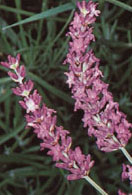View crop
View crop Data sheet EcoPortLavandula angustifolia
 |
|
| Notes |
|---|
| BRIEF DESCRIPTION An aromatic, branched, and spreading shrub reaching a diameter of 80-120 cm and a height of 40-100 cm including the 20-40 cm long flowering shoots. The leaves are 30-50 mm x 2-5 mm, greyish-green and pubescent, and the flowers are violet-blue. USES It is cultivated for an essential oil, flavoring, and as an ornamental. Distilled flowers yield an essential oil used in perfumes, toilet waters, cosmetics, shaving cream, lotions, and soaps. Leaves are used to flavor salads, dressings, fruit desserts, jellies, wines, and herbal teas and to scent linen, sachets, and tobacco. It is also used for erosion control. KILLING T The above ground parts of true lavender may withstand frosts of -15 to -20°C during the dormant period. GROWING PERIOD Perennial, with an economical life of 20-30 years. First harvest may be taken after the third year. COMMON NAMES True lavender, Medical lavender, Smelling lavender, Thin-leaved lavender, English lavender, Common lavender. FURTHER INF Scientific synonym: L. vera. True lavender is native of southern Europe and the Mediterranean region. Lavender is very characteristic of the dry, wild, frequently stony areas between the Alps and the Mediterranean. The plant can in the Alps be found up to 1700 m in elevation. Average yield of essential oil is 16-40 kg/ha or 400-500 kg/ha of dried flowers. | Sources |
| SOURCES (L. angustifolia Mill.) Hornok L 1992 pp 176-183 [DEP, TEMP, KTMP, LIG, DRA, USE] Roecklein J 1987 pp 89 [USE] Langer R 1991 pp 284 [TEMP, DRA, LIG, USE] Duke J 1975 pp 19 [PH, RAIN, TEMP] |